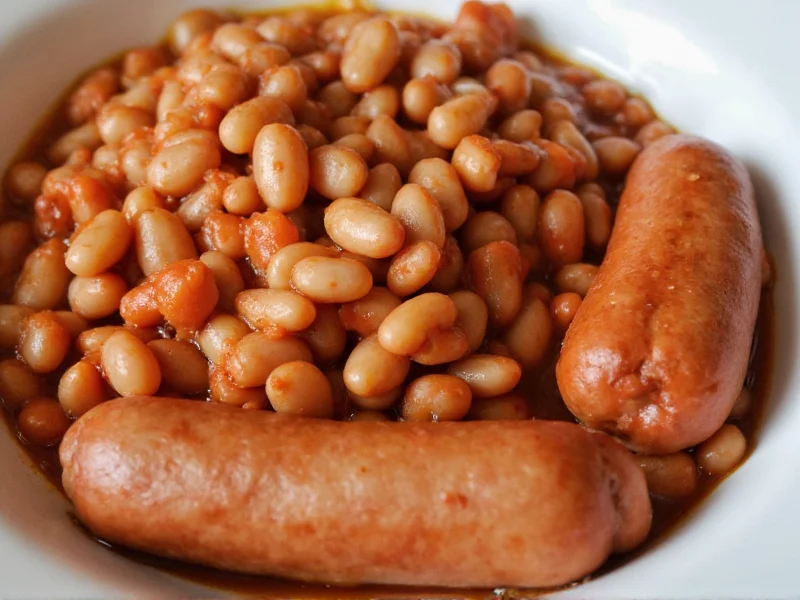The Cultural Roots of Sausage and Beans
Sausage and beans has deep roots in British culinary tradition, emerging as a staple during the Industrial Revolution when workers needed affordable, filling meals. Originally served as part of the classic "full English breakfast," this combination gained popularity due to its simplicity and nutritional balance. While canned baked beans became widely available in the early 20th century, the dish's origins trace back to traditional British pork sausages paired with navy beans slow-cooked in a tomato-based sauce.
Across different cultures, variations have emerged. In the United States, the dish often features kielbasa or bratwurst with navy beans, while Australian versions might include gourmet sausages with tomato-rich bean sauces. Despite regional differences, the core concept remains consistent: quality sausages complemented by perfectly cooked beans with balanced seasoning.
Essential Ingredients for Authentic Flavor
The magic of sausage and beans lies in selecting the right components. Not all sausages and beans create the same results. Understanding which varieties work best can transform this simple dish from ordinary to exceptional.
| Ingredient | Recommended Type | Why It Matters |
|---|---|---|
| Sausages | Pork breakfast sausages or high-quality bangers | Fat content provides flavor; avoid overly processed varieties |
| Beans | Haricot beans in tomato sauce | Navy beans hold shape better than other varieties |
| Bean Sauce | Tomato-based with moderate sweetness | Avoid overly sweet or vinegary commercial sauces |
| Seasonings | Fresh herbs, Worcestershire sauce, mustard | Enhances depth without overpowering |
Perfect Sausage and Beans Recipe
Creating the ideal sausage and beans requires attention to cooking technique. Many home cooks make the mistake of simply heating canned beans and sausages separately then combining them. For superior results, follow this professional approach that elevates traditional British sausage and beans recipe to restaurant quality.
Step-by-Step Preparation
- Prepare the sausages: Cook sausages in a dry skillet over medium heat for 8-10 minutes, turning occasionally until browned and cooked through. Remove and set aside.
- Enhance the beans: In the same skillet, pour in quality canned beans (drained of excess liquid). Add 1 tablespoon Worcestershire sauce, 1 teaspoon Dijon mustard, and a pinch of dried thyme.
- Simmer for depth: Cook beans over medium-low heat for 8-10 minutes, stirring occasionally, allowing flavors to meld and excess moisture to evaporate.
- Combine elements: Return sausages to the skillet, nestling them into the beans. Cook for an additional 3-4 minutes until everything is heated through.
- Finish properly: Remove from heat and let rest for 2 minutes before serving to allow flavors to settle.
Popular Variations for Different Diets
Modern interpretations of this classic comfort food sausage and beans accommodate various dietary preferences while maintaining the dish's essential character. Understanding these adaptations helps you customize the meal to specific needs without sacrificing flavor.
Vegetarian and Vegan Options
For those seeking a vegetarian sausage and beans alternative, quality plant-based sausages work well with traditional baked beans. Look for sausages made from pea protein or mushrooms that provide similar texture and umami flavor. When preparing homemade sausage and beans for vegan diets, replace Worcestershire sauce (which contains anchovies) with a vegan alternative and ensure your beans don't contain animal-derived ingredients.
Regional Twists
In the American South, sausage and beans often incorporates smoked sausages with a touch of cayenne pepper. Northern European versions might include juniper berries and allspice in the bean mixture. For a healthier take on traditional sausage and beans, opt for turkey sausages and low-sodium beans, but be careful not to compromise on flavor development.
Proper Serving and Storage Techniques
Serving sausage and beans at the right temperature significantly impacts enjoyment. The ideal serving temperature is between 165-175°F (74-80°C), hot enough to release aromas but not so hot that it masks flavors. Traditional British presentation includes sausages arranged atop the beans, often with a sprinkle of fresh parsley.
For storage, cool leftovers promptly and refrigerate in an airtight container. Properly stored sausage and beans maintains quality for 3-4 days. When reheating, add a splash of water or broth to restore moisture, as beans tend to absorb liquid as they sit. The dish often tastes better the next day as flavors continue to meld.
Frequently Asked Questions
What's the difference between traditional British sausage and beans and American versions?
British versions typically use pork bangers with tomato-based baked beans, served as part of breakfast. American interpretations often feature different sausage varieties like kielbasa with navy beans, presented as a dinner dish. The British version tends to have a sweeter bean sauce while American versions may incorporate more spices.
Can I make sausage and beans from scratch instead of using canned beans?
Yes, you can prepare homemade sausage and beans using dried navy beans soaked overnight and slow-cooked in a tomato-based sauce with onions, garlic, and spices. While more time-consuming than using quality canned beans, this method yields superior flavor and texture control. The cooking process typically takes 2-3 hours for the beans alone.
What's the proper way to heat beans for sausage without making them mushy?
To prevent mushy beans when preparing sausage and beans, drain excess liquid from canned beans before heating. Simmer gently over medium-low heat rather than boiling vigorously. Stir occasionally but not constantly, and remove from heat when beans are just heated through. The residual heat will continue cooking them slightly. For best results in traditional sausage and beans preparation, simmer beans for no longer than 10 minutes after adding flavor enhancers.
Which sausages work best for sausage and beans?
High-quality pork breakfast sausages or traditional British bangers provide the ideal fat content and flavor for sausage and beans. Avoid overly processed sausages with high water content. For different flavor profiles, consider apple-flavored sausages for sweetness or smoked varieties for depth. The sausage should complement, not overpower, the beans.











 浙公网安备
33010002000092号
浙公网安备
33010002000092号 浙B2-20120091-4
浙B2-20120091-4